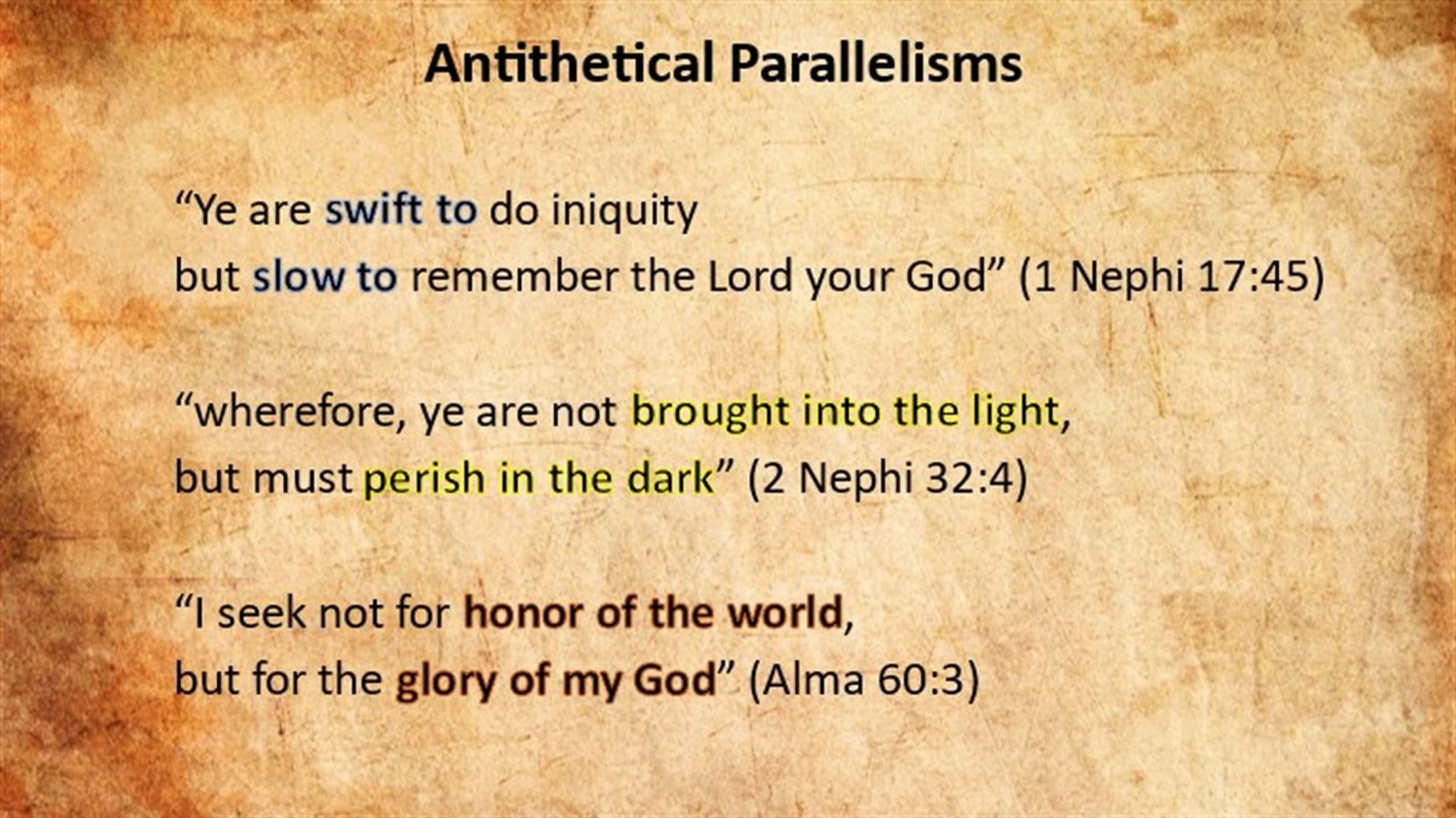Evidence #282 | December 13, 2021
Book of Mormon Evidence: Antithetical Parallelisms
Post contributed by
Scripture Central

Abstract
The Book of Mormon’s use of antithetical parallelisms provides evidence of its Hebrew literary origins and textual complexity.As defined by Hebrew scholar Donald Parry, “Antithetical parallelism is characterized by an opposition of words, expressions, or ideas, or an antithesis between two lines.”1 Typically, this involves multiple elements that antithetically correspond to one another, embedded in parallel phrasing or grammar. This is exhibited well in a passage from Isaiah 1:19–20:
If ye be willing and obedient, ye shall eat the good of the land:
But if ye refuse and rebel, ye shall be devoured with the sword
Notice how the phrasing has the same basic structure in each line: if ye (x) and (y), ye shall (z). Then, in each case, the corresponding variables have an antithetical relationship:
x = “willing” vs. “refuse”
y = “obedient” vs. “rebel”
z = “eat the good of the land” vs “devoured with the sword”
Antithetical parallelisms can be found in sentences with various grammatical structures and different corresponding elements. Here are several examples from the Book of Mormon:
Ye are swift to do iniquity
but slow to remember the Lord your God.
wherefore, ye are not brought into the light,
but must perish in the dark.
I seek not for power,
but to pull it down.
I seek not for honor of the world,
but for the glory of my God
Conclusion
Antithetical parallelism happens to be “one of the most prominent types of parallelisms in the Bible.”2 That being the case, it should come as no surprise that it is also found in the Book of Mormon (see Appendix). It’s presence in the Nephite record provides evidence of its Hebrew literary origins, while also manifesting one aspect of the book’s textual complexity.
Donald W. Parry, Preserved in Translation: Hebrew and other Ancient Literary Forms in the Book of Mormon (Salt Lake City, UT: Deseret Book; Provo, UT: BYU Religious Studies Center, 2020), 19–22.
Carl J. Cranney, “The Deliberate Use of Hebrew Parallelisms in the Book of Mormon,” Journal of Book of Mormon Studies 23, no. 1 (2014): 140–165.
Donald W. Parry, Poetic Parallelisms in the Book of Mormon: The Complete Text Reformatted (Provo, UT: Neal A. Maxwell Institute for Religious Scholarship, 2007).
Donald W. Parry, “Hebraisms and Other Ancient Peculiarities in the Book of Mormon,” in Echoes and Evidences of the Book of Mormon (Provo, UT: FARMS, 2002), 155–189.
Hugh J. Pinnock, Finding Biblical Hebrew and Other Ancient Literary Forms in the Book of Mormon (Provo, UT: FARMS, 1999).
Antithetical Parallelisms
1 Nephi 6:5
1 Nephi 17:37
1 Nephi 17:45
2 Nephi 19:12
2 Nephi 19:17
2 Nephi 19:21
2 Nephi 20:4
2 Nephi 32:4
Jacob 4:10
Mosiah 4:24
Mosiah 5:2
Mosiah 7:29
Mosiah 13:29
Mosiah 29:12
Alma 7:8
Alma 26:12
Alma 32:32
Alma 36:4
Alma 60:36
3 Nephi 12:33
3 Nephi 13:12
3 Nephi 18:25
Mormon 9:23
Mormon 9:29
Ether 12:26
Moroni 7:45
Moroni 8:8
Moroni 10:6
- 1. Donald W. Parry, Poetic Parallelisms in the Book of Mormon: The Complete Text Reformatted (Provo, UT: Neal A. Maxwell Institute for Religious Scholarship, 2007), xxxi.
- 2. Parry, Poetic Parallelisms in the Book of Mormon, xxxi, citing Jose Krasovec, Antithetic Structure in Biblical Hebrew Poetry (Leiden: Brill, 1984), 137.